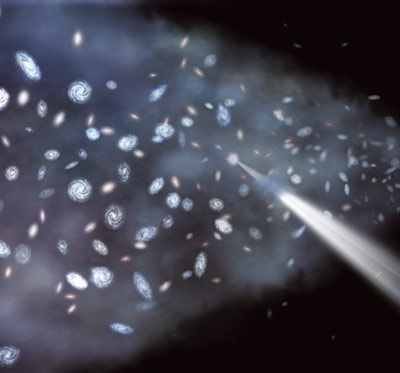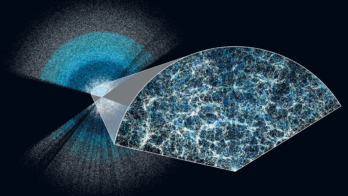
An artist's illustration of gas and galaxies in the Sculptor Wall crossed by the beam of light from a background blazar.
Image credit: NASA/CXC/M Weiss.
X-ray observations suggest that about half of the ordinary, baryonic matter in the universe is in the form of hot, diffuse gas. The detection of absorption lines from the Sculptor Wall by the two leading European and American X-ray satellites is the strongest evidence yet that the “missing matter” in the nearby universe is in the form of diffuse gas, located in the web of large-scale structures.
The composition of the universe has been precisely determined in the past decade by cosmological studies, in particular by the analysis of the fluctuations in the map of the cosmic microwave background radiation (CERN Courier May 2008 p8). The matter-energy content of today’s nearby universe is dominated by dark energy and dark matter, with less than 5% in the form of ordinary, baryonic matter. Observable matter in the form of stars and gas inside galaxies accounts for about only one half of the nucleons (protons and neutrons) expected from cosmology. The other half remains elusive.
The vast amount of hot, X-ray emitting gas that pervades clusters of galaxies often contains several times the mass of the actual galaxies (CERN Courier July 2003 p13). This suggests that the “missing matter” could be of similar nature, possibly slightly cooler (105–107 K) and less dense so that it remains almost undetectable. An alternative to a direct detection of such a warm–hot intergalactic medium (WHIM) is to search for the absorption of X-rays from a background source shining through this gas. A strong claim for the detection of absorption lines that could be attributed to the WHIM on the line of sight to the bright blazar Markarian 421 was published five years ago (CERN Courier March 2005 p13). However, as Taotao Fang – the lead author of the new study – points out, this earlier work was the subject of quite some debate. The main issue is that the location of the intervening gas was determined through a blind search. Therefore, the quite high significance of the X-ray absorption lines is reduced by the fact that the position of these lines was not known a priori and that they could appear at any redshift between the background source and the Earth.
The new study by Fang of the University of California, Irvine, and colleagues is more robust because it searches for absorption at the position of a known foreground structure that is likely to have associated WHIM.
The team focused on a nearby filamentary structure – the Sculptor Wall – containing thousands of galaxies and chose a suitable background blazar called H2356-309 as the source of X-rays. Blazars are a type of active galaxy with a relativistic jet that points towards Earth and produces a featureless radiation spectrum. This makes it easier to detect feeble absorption lines from atoms along the line of sight. Long observations of H2356-309 with NASA’s Chandra X-ray observatory and ESA’s XMM-Newton satellite allowed Fang and collaborators to obtain a significant (4 σ) detection of an absorption line originating from highly ionized oxygen (O VII) at a redshift coinciding with the distance of the Sculptor Wall and consistent with the predicted temperature and density of the WHIM.
This detection by two independent satellites is the best evidence yet that the missing baryons are in the form of WHIM. The detection in the Sculptor Wall, stretching across tens of millions of light-years, suggests that the WHIM follows the filamentary, large-scale structure of the universe outlined by the distribution of galaxies and dark matter (CERN Courier September 2007 p11).





